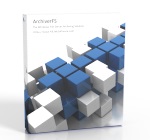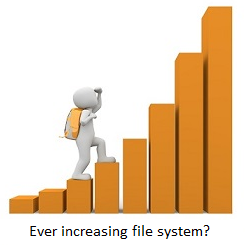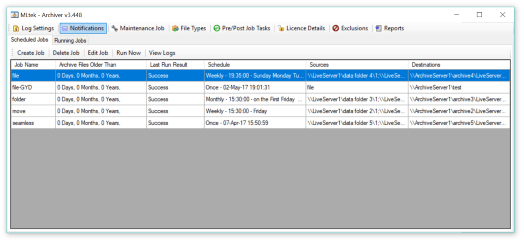
Now on SourceForge!
ArchiverFS was recently added to SourceForge, please feel free to head on over and leave a review.
ArchiverFS - Archiving Solution For File Servers & Network Storage
Home | Product Home | Pricing | Download | Documentation | Release Notes | Customers
The file archiving solution for congested servers that automatically moves old files from network file systems to NAS, SAN, or Cloud based second tier storage.
- Automatically archive old and stale files on mass from your primary storage tier to archive storage.
- Leaves symbolic links behind in place of archived files so users retain instant seamless access to archived content.
- Use any device that supports SMB & NTFS\REFS as archive storage.
- No proprietary storage mechanisms or tie-ins, 100% NTFS\REFS.
- No client software to install, we only use functionality that is already in the Windows kernel.
- The directory structure and permissions of the live file system are maintained, being automatically replicated to your archive storage.
- The lowest TCO of any solution for file system archiving.
Featuring full support for cloud, DFS, replication, de-duplication, and compression ArchiverFS lets you use any NAS, SAN or cloud platform as storage for your old unstructured files. If you can share it to the network with a UNC path and format it with NTFS (or REFS) then you can move your old files to it.
Unlike other file archiving solutions (see the How it Works page for an overview) ArchiverFS doesn't use a database to store files, pointers to files or file meta data. We use pure NTFS (or REFS) from start to finish. It is this approach that gives ArchiverFS it's tiny footprint on the host system. First released in 2002 ArchiverFS is now in use with a huge range of organisations worldwide, many of which are household names.
When ArchiverFS moves an old file to archive storage the files associated directory structure is also persisted complete with all permissions, attributes and timestamps. As part of the file migration process ArchiverFS can leave behind a selection of stubs in place of any old files that have been moved to ensure end users maintain seamless access. The archive storage tier becomes a mirror copy of the live file system but one that contains only the old unused files.
When we created ArchiverFS we didn't want to use a database to store files, file metadata or even the location of archived files. This approach is completely unique amongst file archiving software for network storage, SMB shares and Windows based file servers. It is this approach which makes ArchiverFS incredibly scalable and hugely cost effective.
Several of our customers have multi PetaByte file systems, but you don't need a huge file system to benefit from ArchiverFS. We have licencing options to fit almost every budget and file system. These provide our customers with the most cost effective way to archive old files possible, being able to archive massive quantities of files over the network to second tier storage like a NAS or SAN while requiring only a small footprint on the host system. It enables you to move, store and then end of life old unstructured files from your storage system in a cost effective and controlled manner, thereby helping you tackle challenges like GDPR and Data Protection compliance.
In addition to our unique approach to file server archiving, only functionality that is already included natively in the Windows operating system is used. ArchiverFS doesn't require the installation of agents on to your workstations or servers, making deployment a breeze.
Hardware agnostic: ArchiverFS lets you automatically archive old files from any UNC path to any UNC path over the network using a range of criteria including age, size and type. The device you use to automatically archive your old files too can be a NAS device, CIFS share, iSCSI volume, a VM or even cloud storage on Amazon AWS, Azure or Google Cloud. As long as the source and target volumes are formatted with NTFS or REFS and are shared to the network with SMB then content can be managed and migrated between them.
No Proprietary Storage, it's NTFS from start to finish: At no point does ArchiverFS try to store files (or even meta-data about migrated files) in a database or proprietary storage mechanism. This is nearly unique amongst file archiving solutions and is crucial as it provides the massive scalability that makes ArchiverFS so incredibly efficient. The largest file system currently handled by our software so far stands at 3.4 PetaBytes of unstructured data, and this is done using a single Datacenter edition licence installed on a small VM with just 4 vCPUs and 6GB of RAM.
 'Direct Access' is used to provide users instant access to content: When a user clicks on a link that was left behind in place of an archived file all of the IO goes straight from the users workstation directly to the file. There are no agents or other components in the way meaning that users don't have to sit around waiting for an item to be returned to the live system before they can access it. Any items that need to be returned back to the live system are returned by the daily maintenance job that runs out of hours. All of the information regarding where each file has been archived too is maintained in the file system itself through the use of directory structures and properties.
'Direct Access' is used to provide users instant access to content: When a user clicks on a link that was left behind in place of an archived file all of the IO goes straight from the users workstation directly to the file. There are no agents or other components in the way meaning that users don't have to sit around waiting for an item to be returned to the live system before they can access it. Any items that need to be returned back to the live system are returned by the daily maintenance job that runs out of hours. All of the information regarding where each file has been archived too is maintained in the file system itself through the use of directory structures and properties.
Multiple link types: Several types of stubs are available to choose from which can be left behind in place of files when they are moved, including completely seamless links that behave exactly like the original item. Both folder and file level shortcuts which are more like traditional Windows shortcuts can also be used, and these offer the advantage of increased compatibility and can even be accessed by Apple Macs using an add-in like 'Win Shortcutter'.
Unique 3 tier storage structure: Including Live, Archived and Graveyard stages. This unique feature enables ArchiverFS to create a true Hierarchical Storage Management solution and archive your old content for a fraction of the cost of a traditional server archiving product.
In addition to the key features above, you also get...
- Installation that is supported on all versions of Windows from 2008 Server on, including Windows Storage Server and Server 2019.
- Seamless compatibility with Windows inbuilt compression and de-duplication, Microsoft Search Server, DFS (Distributed File System), SAN based replication and SDS.
- Established product with a broad customer base. ArchiverFS is in use with a wide range of organisations from multi-billion dollar global companies to military contractors, law enforcement departments, government institutions, universities and everything in between in over 40 countries.
- Permissions and attributes that are 100% preserved at all times thanks to the use of pure NTFS (or REFS) for second line storage.
- Unique daily Maintenance Job that returns recently used files back to the live system and exactly replicates each items permissions from the live system to the second line storage.
- Full unicode support for most of the file system character sets in the world including English, Chinese, Arabic, Hindi and many more.
Both Perpetual and subscription licences are available: Subscription licences are available for just over $1590 (approx £1100) for 2 TB of processing, and that is for each TB of files archived from the live system to second line storage. Unlike other file archiving software we don't charge based on the amount of old data that is sat idle in second line storage. Subscription pricing is based on the size of the files you move from live to archive storage in a given year, and not how much data you have sat in second line storage. After all it is your storage, why should you pay year on year just to have content sat on it?
Deployment enables the migration of an unlimited number of old files from first line storage like a file server to any UNC path (NAS, SAN, On-premise, Cloud, etc.) whilst maintaining the NTFS permissions, properties and timestamps of your files in a seamless and efficient manner. You get all of the options you would expect from other solutions as well as the flexibility to archive your content in whichever way suits you, and not some company who is trying to get you to sign up for a five or six figure sum year on year just to hold your old data for you!
Why auto archive your old files to second-tier storage?
Slash restore times in the event of a disaster: What if you could just restore the items that people actually needed first in the event of a disaster, and worry about the rest later? We will enable you to completely separate the first and second tier storage, thus making this approach possible. What's more, with us you won't need to re-install any agents or client software to get back up and running, thus making recovery in the event of a disaster much faster.
Free up space on your expensive first tier storage: The less data you try to store on your first tier storage the longer it will last. We have all been there at one time or another, you specify a new storage system by predicting the amount of space you'll need in a few years time, and then you add something from 20% to 100% just to be sure. A year down the line you find that the data has grown far faster than anyone expected and you have to start looking at buying extra spindles for your storage layer, or attaching extra shelves. We will help you tame that growth thus extending the life of your file systems.
Ensure regulatory compliance: In Europe we have the GDPR regulations, and most other countries have something similar. These regulations almost invariably require companies to consider how long they can retain data for. Meeting these requirements is extremely challenging for most companies which dont use some form of file archiving solution, especially if they have a lot of unstructured data. We will enable you to specify how long you want to keep file system data for before it is disposed of.
Cut the amount you spend on backups and other services: Old data doesn't change much. Yet every time you do a full backup of your systems you will be backing up old static content. With your old files moved to second line storage you can back them up less frequently, thereby saving on backup costs.
What next?
Feel free to drop us an email if you have any questions about ArchiverFS.
When you download a free copy of ArchiverFS it comes with a free licence that lets you create up to 5 scheduled jobs. The only limitation is a limit of 100 files processed each time a job runs, which is perfect for smaller deployments or those looking to take it for a test drive.
